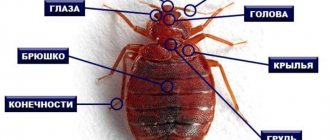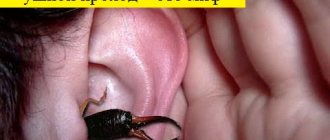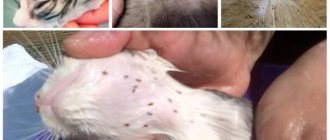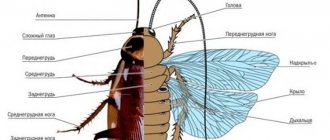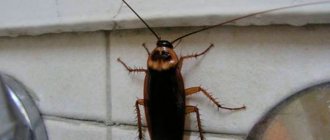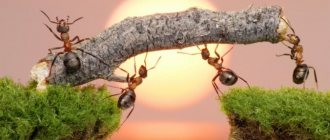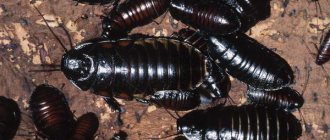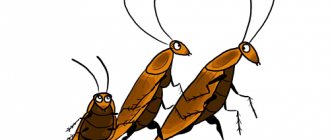Are there flying cockroaches?
Perhaps people don’t know as much about any insect as they do about cockroaches. Everyone has seen it live in their kitchen or somewhere else, obviously not in a photo on the Internet; myths and scary tales are made up about its ability to survive and its adaptation. But for some reason, when it comes to his ability to fly, everyone begins to doubt. Strange, isn't it?! Cockroaches, like almost all insects, have two pairs of wings. In front are the so-called integumentary wings, which cover the delicate part of the hind wings. Both pairs are needed for flight. But whether there are flying cockroaches, whether cockroaches can jump high remains a subject of debate and controversy.
What types of cockroaches can fly?
Whether a cockroach has wings is clear. Whether domestic cockroaches or other members of the family fly remains to be seen. Species that have mastered the art of flight are listed below.
Asiatic
A relative and twin species of the Red Prussian. It flies well, but is not a synanthropic species (lifestyle associated with humans). Such insects often fly into windows and can establish colonies in human homes.
American
Another species that clearly shows whether cockroaches fly is called the American cockroach. These insects came from Africa and firmly established themselves in states with warm climates. They live in garbage chutes, collection systems, warehouses and industrial buildings. This degree of habitat selection is due to the large number of cockroach colonies.
The American cockroach does not need gastronomic delights and feeds on food waste, paper, leather and synthetic materials. The body of an adult reaches 5 cm and has a reddish color. Developed wings help with short flights. The female makes 80-90 clutches, each of which contains 10-15 eggs. Fertilization occurs without the participation of a man. American cockroaches are reddish-brown in color with a yellowish figure-eight pattern on the back of their heads. The American cockroach is the largest of the domestic cockroaches.
Interesting!
The female American cockroach is a very caring mother and cares for the newborn offspring, which is not typical for most species of the cockroach family.
Cuban
The Cuban cockroach is distinguished by its light green color. They grow to two or two and a half centimeters. They really enjoy flying at night to the lights on buildings. Very risky guys.
Australian
This is an insect (body length - 3-4 cm) with a reddish-brown or red-brown color. It causes particular harm when it fills greenhouses or greenhouses.
Green banana cockroach
Representatives of the species Panchlora nivea are found in the tropical forests of the Caribbean islands, Cuba and Florida. They are small in size 17-22 mm. Light green adults jump and fly beautifully; the larvae prefer to burrow into the ground. In the evening, adult individuals actively fly towards the light; during the day they fly up to flowering banana palms for nectar. The larvae feed on plant debris.
Woody
This type of insect reaches a length of 3 cm and has a dark brown or reddish color. Females fly poorly. The reason for this is that the wings are not fully formed. And males fly successfully, like most insects.
Smoky
This species has a dark brown color, the length of the body reaches 2-3 cm. Trying to get food, they often fly into an open window of an apartment and can settle there in whole colonies, but more often they populate forest trees.
Laplandian
Outwardly, it resembles an overgrown Prussian (its size is 3 times larger than that of red Prussians). They are record holders among their peers in terms of flying distances and ability to glide in the air. The insect feeds on plant foods - lichens growing on trees, dry leaves.
Madagascar
This is a well-known representative of flying parasites. Its body length can reach 8-9 cm, and its wingspan is up to 20 cm - this is a large size. The homeland of this insect is the island of Madagascar. But the parasite can be found in some families (domestic insects) or in zoos around the world.
Megaloblatta longipennis
The inhabitants of South America (Ecuador, Peru) are the largest cockroaches with wings. Their body length is 76-95 mm, wingspan up to 200 mm. The insects are listed in the Guinness Book of Records. The second characteristic feature of the species is the high fertility of the female. During her life, she lays about 50 cocoons with eggs, giving rise to an entire colony.
Homemade
Domestic individuals (red or black) do not have special flying abilities. And insects, whose habitat does not depend on human activity, purposefully use their wings for their intended purpose. In wild conditions, the ability to fly is more justified.
Saussure's turtle
Insects native to Central Asia live in clay deserts. The species has developed sexual dimorphism. Females are round, convex, and resemble turtles. Body length 45-50 mm. Their wings have atrophied. Males are oval, dark, have long, developed elytra. Retained the ability to fly.
Giant cave (forest) cockroach or Blaberus giganteus
The insects are found in the forests of Central and South America. Adults live in trees, and larvae burrow into the litter. Females are larger than males, body lengths are 8 cm and 7 cm, respectively. The wings are well developed; insects fly from branch to branch and glide from a height. Exotic lovers often get Blaberus.
Information. When keeping flying cockroaches as pets, the terrarium must be covered with a net.
Flying cockroaches use their wings during courtship with a female. To attract a partner, not only pheromones are used, but also special movements. The male raises wide transparent wings, waves them, making a chirping sound. If the female accepts courtship, the wings rise fully and she climbs onto the male's back.
Do domestic cockroaches fly?
First, nature gives a living creature a complete set of organs. Then those that are not used gradually die off. Domestic cockroaches' wings have atrophied, but their paws and respiratory organs have developed. The insect breathes with its entire body and does not need its head for this. Therefore, an effective way to combat them is to spray directly on the insect itself.
It is necessary to spray directly onto the insect itself.
Cockroaches living next to humans get everything they need on the floor and nearby. They inhabit the secluded places closest to the source of life. Insects run very fast, covering a distance of 50 times their body length in 1 second. This is like a person of average height running a hundred meters from a standstill in 1.2 seconds. There is no need for flights.
A cockroach can only live without water for a week. A clean kitchen and non-leaking taps can protect against the invasion of domestic cockroaches. From the Americans, there are nets on the windows and sealed cracks in the floor.
The legs of cockroaches are adapted to hold them on horizontal and reverse vertical surfaces - walls and ceilings. They fall extremely rarely. On foot during the night - the active period of activity - up to 1000 meters are covered. This is quite enough to crawl not only around the entire apartment in search of food, but also to go to the next one and go down to the trash heap.
Night is enough for a cockroach to crawl not only around the entire apartment in search of food, but also to go to the neighboring one.
Domestic cockroaches do not store supplies; they only eat all the time when they are not sleeping. Having a good sense of smell, they quickly find food, examine it with the help of antennae and crush it with strong jaws.
Can cockroaches fly in real life? Mostly they just glide while falling from a height. Red Prussians use their wings to help them run faster in case of danger. Sometimes they can jump 30–35 cm to escape from a person. For this, only a thin wing is used. The elytra simply protects the body. But it happens that red domestic cockroaches use their wings:
- 1 Flights to another habitat in case of overcrowding of the place where they live. Those who want to see the flight of the Prussians may not poison them and over time it will be possible to see how some of them leave your home. There will be much more left and flights may become regular.
- 2 After one mating, females store the seed for a long time and lay eggs. They do not require a large number of males for reproduction - one for every 3-5 individuals. When there is a disproportion in the sex ratio, the males fly to another place.
- 3 Lack of nutrition or its imbalance forces insects to look for more nourishing places. It is enough to feed the uninvited tenants well for a while, leaving bread, herbs, meat on the table, grease on the panels and dirty dishes in the sink with a dripping tap. Then do a quick cleaning, removing garbage, food and washing the sink and panels. Take a flashlight at night and wait.
Do the cleaning, remove the trash, food and wash the sink and panels, use a flashlight at night and wait for the cockroaches to fly
Good weather outside can also make domestic cockroaches fly. When the house is cold and dry, but it’s raining and warm outside.
Another reason is the colonization of the house by larger and stronger insects, such as black and American insects. If you have good living conditions, there will be a fight for your housing. The Prussians, as the weaker ones, will be forced out. They don’t touch furniture, they have different food and places for nests.
Female black cockroaches have poorly developed wings and are unable to lift them into the air. Representatives of both sexes use both pairs of wings during mating. They open them and shake and vibrate. Males sometimes glide over the female at a low altitude.
Black cockroaches have poorly developed wings
Americans are real flying cockroaches. They fly freely over a distance of several meters. Living mainly in garbage dumps, they leave freely when their habitats are disinfected. At the same time, they often fly into windows and move into apartments. And vice versa, when insects begin to be poisoned in the house, they fly out into the street. It is difficult to remove the American cockroach. Thanks to flights, he is mobile and constantly moves away from danger.
Why do cockroaches need wings?
Despite having four wings, each flying cockroach uses only one pair for air travel. Thick and protective, the front pair of wings are the same coloring as the cockroach and lie close to the insect's back when not in use.
The back pair of wings remain hidden and protected under the front pair until the cockroach takes flight. In preparation for flight, cockroaches raise their front wings to expose their hind wings.
During flight, insects raise their front wings and move through the air using the rear pair. Unlike the front pair, the hind wings of flying cockroaches are membranous, thin and transparent.
Cockroaches are more likely to fly if they feel threatened and need to get away quickly. They can also use their wings as gliders if they find themselves in a high place and need to get lower to glide rather than fall. However, it is more likely that at home you will see cockroaches running around on the table or floor and not flying very often.
How do flying cockroaches reproduce?
Depending on the species, place of residence, availability of heat, food and moisture, cockroaches reproduce more actively, or vice versa less.
The development of wings and active flight are recognized as one of the most significant evolutionary innovations in insects, which not only allowed them to reach many new habitats, but also led to their diversification into countless forms.
However, a large number of members of nearly cockroach species exhibit some degree of wing reduction.
Wing contraction and loss of flight occurred independently during insect evolution. Recent research unexpectedly shows that not only wing gain but also wing loss is associated with faster molecular evolution and increased speciation in insects.
In addition, wing contraction is associated with numerous morphological, physiological and behavioral changes that have both ecological and evolutionary significance. It is widely believed that wings are no longer needed in stable or isolated habitats where dispersal of insects is practically impossible or not necessary for their survival. Examples of such habitats include islands, caves, high mountains, or shelters.
However, sexual dimorphism in the wings occurs in many species, with one sex—almost exclusively females—showing a higher degree of wing contraction than the other sex. In many cases, this dimorphism is so extensive that the females are completely wingless, while the males remain fully winged. In such cases, the prevailing assumption is that the insect's wing contraction is driven by directional selection.
Cockroaches, being one of the most diverse polynopteran groups and exhibiting one of the highest expressions of forms with reduced wings, have achieved almost every possible wing state: from fully developed wings (macropterous), forms with varying degrees of reduction (brachyterous and microterpterous) to completely absent wings (aperthetic) in one or both sexes.
- However, it is the female that precedes the male in wing contraction, which results in the commonly occurring sexual wing dimorphism. Despite the incredible diversity of cockroach wings, there are no studies examining the significance of their reduction and their evolutionary consequences.
- It is possible to explain the reduction of the female wing in cockroaches as a consequence of selection for higher or faster reproduction in species where active flight is not inevitable for survival. However, what to do if wing maintenance, even in non-flying form, is an important problem for males? While studying courtship behavior, scientists noticed that it is very ritualistic and surprisingly uniform among cockroaches.
- Once near a receptive female, the male moves his abdomen up and down with his wings slightly raised and displays himself to the female.
- It then raises its wings higher to expose the entire ventral dorsum.
- The female responds by climbing onto his back, where she palpates the tergites and licks the products of the triple glands. At this moment, the male captures the female genital organs using a genital hook located on the extensible phallomere.
- When the connection is made, he moves forward, causing the female to turn 180 degrees from his back. The pair then stabilizes in a typical end-to-end position until copulation is terminated.
- Some authors argue that palpation and licking of the tergite glands is necessary to maintain the female in a position allowing union. In addition, one would immediately expect that the trigeminal glands could function as a nuptial gift. As a result, wing raising, a specific behavioral element performed during the act of courtship, is simply viewed as an inevitable movement that must be performed in order to open the territorial area for female access.
- Recent studies have proven that it is the male wings that can help maneuver the female in a position that ensures communication. Therefore, the preservation of wings in male cockroaches is important for their successful and timely mating.
Does a cockroach's diet depend on its ability to fly?
Flying cockroaches are usually found in warmer areas as they are more active and tend to fly more often because they need to travel further to find food. In big cities, cockroaches don't have to travel as far to find more food, so they fly less often. Because they don't really need to fly that often, this ability has atrophied. Their muscles don't get the exercise that those that fly more often do, so it's less common to see cockroaches flying in big cities or where it's colder.
Flying forest cockroaches have their own diet. Flying cockroaches, which prefer scum, are certainly better adapted due to their ability to fly short distances in search of food.
What cockroaches fly well?
Our red Prussians and their overseas relatives are extremely heat-loving; at temperatures below -5 ° C they die, so they live either in constantly heated rooms or in hot climates.
Hypothetically speaking about whether domestic cockroaches can fly, it is worth thinking about why they need it. Inhabitants of houses and apartments do not need to travel long distances in search of food or escape from insectivorous predators. Therefore, during evolution, their ability to fly was completely or partially lost.
Species living in the wild are another matter. They need wings during the mating season and as a means of transportation, for example, during periods of drought, because these insects drink a lot.
They run fast, but fly reluctantly
But what every cockroach without exception is famous for – with and without wings, flying and non-flying – is sprinting. Three pairs of legs of unequal length, covered with bristles and sharp spines, clearly perform different, but at the same time interconnected functions, which allows the cockroach to move rapidly across surfaces.
According to some estimates, thanks to the coordinated work of its six legs, a cockroach at a sharp start in the first second covers a distance 50 times the length of its body! For comparison: in order for a person to run a distance equal to 50 body lengths in a second, he will need to reach a speed of about 320 km/h.
And you know what’s remarkable: even flying species of cockroaches move more willingly and much more often using their legs than their wings. These creatures resort to flight only in exceptional cases and only for short distances. For example, a cockroach can fly up in a moment of sudden danger, when the situation does not allow it to run for cover. Flying cockroaches also use their wings as gliders when they need to quickly descend from a high place to a lower place.
If anyone has ever seen a cockroach flying in person, consider it lucky; not everyone is lucky enough to witness such a rare phenomenon.
Why cockroaches rarely fly
In short, cockroaches don't like to fly. A flight distance of 2-3 meters is considered impressive for these insects, but even such flights are only possible for some species.
The reasons for cockroach aerophobia obviously lie in simple physiology. The mass of their body is simply too large in comparison with the size of the wings, and therefore flight is so difficult for them; it is difficult for cockroaches to maneuver in the air, and they are unable to fly a significant distance. For the combination of these reasons, the cockroach prefers to run to its destination rather than fly.
How to distinguish a red cockroach from an American one
A person far from entomology will easily confuse the Prussian and the “American”. Both species have a fairly narrow body and are colored in different shades of brown. Only American cockroaches are shiny, with a chocolate or red tint, while Prussians are duller, brownish-red.
Another difference is the size. The body size of an adult European cockroach is only 1-1.6 cm, while American cockroaches grow up to 3.5-5 cm in length.
Red cockroaches are typical synanthropes and are rarely found outside human homes. Their American relatives are more adapted to life in the wild and willingly settle in public buildings and underground utilities. Therefore, the personnel servicing tunnels and basements will gladly share their observations of whether cockroaches can fly, using the example of the ubiquitous “American”.
The behavior of these insects is also different. Prussians are harmless, except for the infection they carry. But the Americans will not give up without a fight and may bite. All types of cockroaches have developed gnawing-type mouthparts, equipped with powerful jaws with chitinous teeth, and the “Americans” successfully use them for defense. And if we add their flight ability, these insects seem almost invulnerable.
How do winged cockroaches reproduce?
Longhorned beetles have an incomplete metamorphosis cycle. When the female lays her eggs, they hatch into small white “babies.” They differ from adults only in the absence of wings. This period has some similarities with the development of butterflies. The small pests are called nymphs.
To become an adult, nymphs molt 6 times, changing their “skin”. After the last time, they take on the appearance of an adult and acquire developed wings.
The female's physique has a special sac, which is designed for bearing eggs. When the time comes, about four weeks, the female separates the pouch, and small white barbels emerge from it.
At one time, a winged female can give birth to up to 30 young. The life cycle lasts less than one year, and a new female reaches maturity in 2 months. As they grow up, they eat different foods and eat just like adults.
Because of these features, red pests have become the most common insects living near people.
What types of cockroaches are found in a house or apartment?
Despite the fact that more than 4,600 species of cockroaches are known, only a few representatives of these insects can be found in houses and apartments. In our climatic conditions, only four types of cockroaches have firmly established themselves: red, black, American and furniture.
To recognize the one that has settled in your home among the described individuals, it is worth getting to know them better.
Red cockroach
This type of parasite is most often found in apartments and houses. The common people call them Prussians. They are difficult to get rid of, but can be found in almost any living space:
- in multi-storey buildings, the private sector;
- in catering establishments;
- in hospitals;
- on street buildings;
- at country dachas.
Representatives of this species are omnivores and feed not only on fresh, but also spoiled foods. They penetrate into refrigerators, bread bins, kitchen furniture, etc.
These parasites reproduce intensively, so the fight against them is usually long-term.
Black beetle
Another striking representative of this order, living in residential premises, is the black cockroach. It comes from basements, sewers and trash cans. The reproduction rate of representatives of this species is higher than that of Prussians.
You can find them where there is at least some food:
- behind the stove;
- under the kitchen unit;
- under the refrigerator;
- in a trash can;
- in the pantry.
The presence of black cockroaches indicates poor sanitary conditions in the premises. The main danger that comes from parasites of this species is due to their lifestyle. Moving through garbage containers and dirty sewers, they carry many infections and pathogenic bacteria into the house on their paws.
Important! Scientists have proven that individuals of this species are active spreaders of hundreds of microorganisms and carry diseases such as ulcers, cholera and E. coli.
American cockroach
The homeland of this species of cockroach is Africa, and from there it came to Europe and America along with goods transported by sea. Thus, insects quickly spread throughout the world.
American cockroaches are heat-loving insects, but they have been able to adapt to our climatic conditions. This type of parasite is distinguished by its great mobility and even to some extent aggressiveness, from which sleeping people and pets can suffer.
Representatives of this species cannot tolerate low temperatures, so they die at 0°C.
Furniture cockroach
The first individuals of this species were discovered in the middle of the last century in the central regions of Russia. Furniture cockroaches are characterized by a bright red color and wings with brown stripes.
Most often, individuals of this species are attracted to food that contains starch. Nests of these parasites can be found in libraries, archives (the spines of old books are rich in wallpaper glue) and other places where there is a source of their saturation.
Why are there so many insects?
Many people mistakenly believe that cockroaches have peculiar “nests” - places where they gather as a colony. This is truly a misconception, since these parasites do not have nests. Cockroaches really tend to gather as an entire colony in one specific place, but this is explained by the fact that they simply find the most comfortable place in the apartment and gather for reasons of comfort.
We invite you to read: Using boric acid in the garden
A person may mistakenly stumble upon one of these places and because of this decide that it is a cockroach nest. You might even think that the cockroaches in the colony have a queen like a bee, but this is not so. Cockroach colonies do not have such an organization.
Cockroaches with wings appeared many thousands of years ago and during this period they learned to survive in the most unfavorable conditions. Thanks to their small size, fast movement, omnivorous nature, ability to acclimatize in difficult conditions, and rapid reproduction, they have captivated the whole world.
As for wings, they simply don’t need them, since humans help insects spread to new territories. Because of this, they lost the need to use this organ.
Red cockroaches (Prussians) have replaced black ones because they can reproduce faster. Black longhorned beetles live far from cities, mainly in rural areas.
Since such pests adapt well to any environment, they live in places where other insects do not occur.
What cockroaches carry into the house on their legs and wings
Curious children sometimes wonder whether red cockroaches can fly, and try to test their guesses experimentally. You should not allow your child to come into contact with insects that carry infections and parasites, for example:
- shigellosis, better known as dysentery;
- catarrh of the stomach and intestines (gastroenteritis);
- eggs of worms (pinworms, roundworms, pork tapeworm and others);
- diphtheria.
Cockroaches can also cause a severe allergic reaction, mainly from the skins shed after molting. Health is more valuable, so you shouldn’t tolerate insects in your home.
What kind of insect is a domestic cockroach?
Fossil remains of cockroaches date back to the Paleozoic era, 541-251 million years ago. Today, scientists have described more than 4,600 species, most of which live in the wild, and some have evolved along with people and have become typical synanthropes. People are more concerned about whether the cockroaches that live in apartments fly. Among the species living in the vicinity of humans, the most famous are the following:
- red cockroach, also known as the Russian cockroach: a numerous and widespread species native to Asia;
- the black cockroach, whose numbers are declining due to its main food competitor, the Prussian cockroach;
- American cockroach, introduced in the 17th century from the African tropics to Europe and North America. A typical cosmopolitan, whose range covers most of the globe.
The black cockroach has a characteristic color, so it is very difficult to confuse it with other domestic species, and it is not common. We have to deal with the Prussian and the similar American cockroach.
It is important to know how to distinguish these insects because they behave differently. However, it is these species that make you wonder: can red cockroaches fly and how well? After all, the more information about the behavior of pests, the more effective it is to fight them.
How to get rid of winged pests
To destroy the entire population that has started indoors, there is one way - to use special chemicals and traps.
Traps will help deal with a small number of parasites and are not intended for large volumes.
There are several types of chemicals:
- sprays, aerosols;
- gels;
- crayons.
The most effective means that can destroy all longhorned beetles in a few hours are aerosol poisons. They are sprayed throughout the apartment, penetrating into all cracks and hard-to-reach places, thereby ensuring maximum effect.
The insecticidal drug enters the Prussian's body through the respiratory system or oral cavity, producing a nerve-paralytic effect.
When using such poisons, you should follow safety precautions and carefully read the instructions for use.
How to fight
How can you effectively deal with a cockroach problem?
Your best bet is a comprehensive approach:
- Improve sanitation to reduce the amount of food available to parasites.
- Reduce clutter so redheads have fewer places to hide and breed.
- Create barriers to limit the Prussians' access to your home. For example, use caulk to seal cracks around electrical outlets and eliminate water leaks that give cockroaches access to the moisture they need.
- Use pesticide powders (such as boric acid or diatomaceous earth). Apply it generously but selectively in hard-to-reach places, such as behind cabinets or under the sink.
- Place insecticidal baits in areas where you see cockroaches but where children and pets cannot reach them. For example, behind the refrigerator.
Chemicals
Insecticides are most effective in controlling cockroaches when combined with sanitation and exclusion methods that limit the cockroaches' ability to reproduce or re-enter. But chemical control alone will not solve the problem. If insecticides are used, they should always be used with extreme caution.
Traditional methods
A cheap natural bait for red cockroaches is boric acid mixed with flour and sugar in equal parts. The pests carry the bait back to the colony, poisoning the lair. Dissolve the mixture in water and spray along the floorboards in the rooms.
Ingredients
- 2 tablespoons solid vegetable oil or lard
- 1/2 finely chopped onion
- 1 teaspoon sugar
- 2 tablespoons boric acid powder
Finely chop 1/2 of the onion (about 3 tablespoons) and place in a small bowl. Add lard, sugar and boric acid to the bowl with the onions. Using a metal fork, mix the ingredients very well. Place half a teaspoon of this mixture on an old jar lid or small dish. You need to “set the banquet” on five saucers, minimum.
Replenish your dishes with bait at least monthly.
Sprinkle this mixture around your door, behind the stove and refrigerator, behind the sofa, etc. As long as it is dry, it continues to work. This is the best remedy for getting rid of cockroaches.
Of course, the cockroach does not make anyone happy in the apartment, and thoughts about how to get rid of the parasite are inevitable. There are several methods of struggle: from folk to specific, aimed at the complete destruction of “stasiks”.
The most common companions of humans are red and black cockroaches
Large and unsociable black ones (Blatta orientalis) or sociable and active red ones (Blattella germanica) belong to the synanthropic species. This means that they prefer to live next to a person, sharing both the table and the house with him. At the same time, they can carry pathogens of intestinal infections and often cause allergies in sensitive people.
Almost everyone is familiar with the character of Prussians (small brownish-red creatures): nimble insects are able to elude a person who wants to crush them, and sometimes appear in broad daylight in the kitchen or bathroom. But domestic cockroaches are especially active at night. In the dark, they feel completely safe and can gather on an untidy table, crawl over dirty dishes in the sink, or show up in a four-legged pet's food bowl.
Adult red cockroaches (domestic) are relatively small, 2-2.5 cm long. They have well-developed wings, but do not fly. This is offset by their extraordinary ability to move across a variety of surfaces and even penetrate closets in the kitchen or bathroom. The flat shape of the cockroach’s body helps it squeeze into barely noticeable cracks, under loosely closed lids or doors, and live behind peeling wallpaper and plastic panels.
Red cockroaches live in large colonies, in which you can simultaneously see both larvae and completely adult individuals. The size of a colony is regulated by its inhabitants: if there is a lack of food or free space, some of the young can be eaten by larger members of the nest. Insufficient nutrition also forces female cockroaches to lay new eggs less often than in times of plenty. Considering the recommendations for getting rid of these parasites, we can conclude that the lack of access to food and water causes them to reproduce less intensively and automatically reduces the size of the colony.
The capsule that the female cockroach lays contains up to 40 eggs. After 2-3 weeks, small larvae (1-2 mm long) can hatch from it. They gradually grow up, and after 3-6 months the insects are ready to reproduce on their own.
